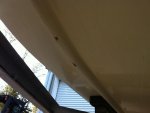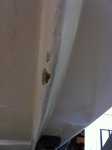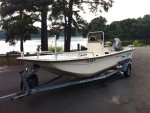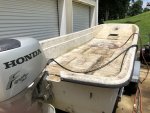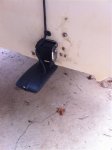righthereinatlanta
Cadet
- Joined
- Jun 6, 2009
- Messages
- 7
I am going to post this across a couple of different forums in an effort to capture as much Forum Expertise as possible. My Carolina Skiff is going through what will probably be it’s last remodel. The T Top and original console are gone, the front and rear decks temporarily removed until, and a new/old stock console that I have had in the shop for a few years ready to be installed. I have pulled all wiring, and have new motor controls (Honda) ready to install. The boat is an early Carolina Skiff, 19 foot V Series. The skiff is pushed around by a Honda 50HP, which usually gets me up to 25 – 27 MPH, plenty of speed for where we fish. This will be a great little boat to pass on when I finish it to my son.
My knowledge level = Solid, I know my way around wiring and the right equipment needed to do the job. My son and I have removed the front and rear decks, and the old console. What I have left is a hull that is in reasonably solid shape, with a couple of scrapes on the bottom. The hull itself is filthy from sitting in the elements for a couple for a couple of years. Typically a good power wash after bleaching works to clean it up. There are multiple screw holes in the hull from the attachment of seats, console, battery trays and so on.
So my initial questions and thirst for knowledge starts here.
Question: Recommended Paint Brand and should I use 3M Marine Sealant or is there a better way to patch and fill screw holes? Some of these are up to ¼” threaded screw holes. There are also small #8 screw holes, transducer and speed indicator on the back that will need to be filled before I remount the new transducer and speed sensor. I would like to seal the holes, and paint the inside of the hull with a durable – multi coat - marine paint made for this. I plan on masking and painting up to the rubber bumper. If the bumper readily come off, I’ll pull before paint.
Question: Best prep before paint? Bleach, Rinse, Pressure Spray, Ammonia, Rinse and dry and then paint?
Question: Is there any chance that the hull area between the bottom and the floor/deck could have water intrusion? The reason that I ask is that when I pulled a couple of screws that filled old transducer holes, I thought that I saw water seepage. These were mounted to the left and right of the sump in the back. Does anyone know if it’s possible/wise to install small deck plates to inspect?
Question: Best exterior cleaner, polish, and finish wax. I have the right auto detail buffers to work the outside, I am just curious on best compounds that should be used.
Question: The ten gallon tank originally was installed below the console. I had two batteries up front under the deck for trolling, and one battery under the back deck for motor and power. I would like to run with two or three batteries and the fuel tank permanently installed in the back, left and right, under the deck. Pros/cons? I’ll figure out how to pull wire back to the front for the trolling motor.
Question: The front deck has a small area that seems to have delaminated, (like an air bubble). Area is still solid, so is there a good way to inject this with epoxy/glue and weight it down until it sets?
Thank you in advance for sharing your thoughts. Nice little boat, safe and it’ll be perfect when finished for my son with your help.
Pictures attached are before and now stripped.
My knowledge level = Solid, I know my way around wiring and the right equipment needed to do the job. My son and I have removed the front and rear decks, and the old console. What I have left is a hull that is in reasonably solid shape, with a couple of scrapes on the bottom. The hull itself is filthy from sitting in the elements for a couple for a couple of years. Typically a good power wash after bleaching works to clean it up. There are multiple screw holes in the hull from the attachment of seats, console, battery trays and so on.
So my initial questions and thirst for knowledge starts here.
Question: Recommended Paint Brand and should I use 3M Marine Sealant or is there a better way to patch and fill screw holes? Some of these are up to ¼” threaded screw holes. There are also small #8 screw holes, transducer and speed indicator on the back that will need to be filled before I remount the new transducer and speed sensor. I would like to seal the holes, and paint the inside of the hull with a durable – multi coat - marine paint made for this. I plan on masking and painting up to the rubber bumper. If the bumper readily come off, I’ll pull before paint.
Question: Best prep before paint? Bleach, Rinse, Pressure Spray, Ammonia, Rinse and dry and then paint?
Question: Is there any chance that the hull area between the bottom and the floor/deck could have water intrusion? The reason that I ask is that when I pulled a couple of screws that filled old transducer holes, I thought that I saw water seepage. These were mounted to the left and right of the sump in the back. Does anyone know if it’s possible/wise to install small deck plates to inspect?
Question: Best exterior cleaner, polish, and finish wax. I have the right auto detail buffers to work the outside, I am just curious on best compounds that should be used.
Question: The ten gallon tank originally was installed below the console. I had two batteries up front under the deck for trolling, and one battery under the back deck for motor and power. I would like to run with two or three batteries and the fuel tank permanently installed in the back, left and right, under the deck. Pros/cons? I’ll figure out how to pull wire back to the front for the trolling motor.
Question: The front deck has a small area that seems to have delaminated, (like an air bubble). Area is still solid, so is there a good way to inject this with epoxy/glue and weight it down until it sets?
Thank you in advance for sharing your thoughts. Nice little boat, safe and it’ll be perfect when finished for my son with your help.
Pictures attached are before and now stripped.




















